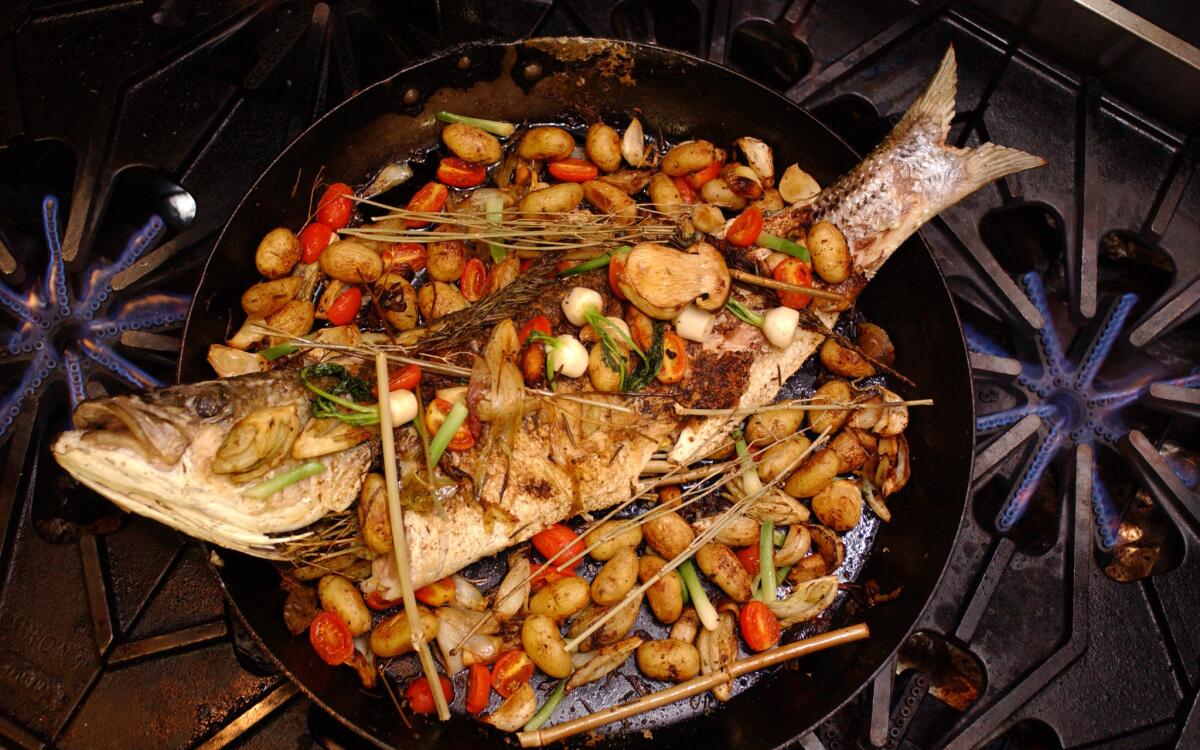Whole baked fish with roasted vegetables

- Share via
As it emerges from the kitchen, the white glistening oblong gives no hint as to what it is, but it is carried so gently and with such a sense of reverence you could imagine it had some religious significance.
It arrives at the table and the restaurant’s manager, his eyes aglow with intensity, bends over it and begins to break away what is in fact a salt crust, and gradually he reveals a whole intact fish, a branzino, that has been roasted in that protective white casing. He gently removes the skin and then begins to lift the flesh from the bone and places it on the plate. The very first taste reveals an unparalleled delicacy and sweetness.
It is all executed with such solemnity and apparent skill that you’d think the only people entitled to do this sort of thing had to be directly descended from Escoffier. But, no, it’s really just performance. The fact of the matter is that roasting and serving a whole fish in salt is as easy as pie. Easier, actually.
The majesty of a whole fish served at the table has always been obvious to restaurants, and they have made a show of it for eons. The fish can, of course, be deep fried, as is common in Chinese restaurants. But roasting is the more nearly foolproof method and -- many would argue -- simply more beautiful.
One of the local masters of the technique is Gino Angelini of Angelini Osteria. His salt-encased branzino sits right at the top of the list of entrees on his menu these days, attracting one diner after another.
The branzino is imported from Italy and France but striped bass or red snapper are fine replacements. Although there are several approaches to roasting fish successfully, the salt crust, which seals in the juices and flavor without actually imparting any saltiness, comes from a rustic Italian tradition and suits the highly regarded little restaurant near La Brea very well.
Aromatic herbs in the salt permeate the flesh without masking its flavor. Of course, there is always the danger of drying out the fish through overcooking. If you make it yourself you’ll have to check for doneness by breaking through the crust with the tip of a knife near the spine or thickest part of the fish. It should look very moist and opaque with no signs of translucency. When it’s done the safest thing to do is let it stand at room temperature for three or four minutes so the crust cools enough to be handled.
The salt is then cracked open with a mallet and discarded. And here’s a caution: Be sure to remove any salt that remains on the platter so that it does not come in contact with the flesh of the fish once the skin is removed. Then remove the head and skin of the fish.
The flesh is removed in two stages. First, almost as if you were filleting it, carefully lift the flesh off the bone and place it on a serving platter or individual plate. Now the center bone is revealed; discard it and any small bones adhering to it. And transfer the remaining fish to the plate.
One way to finish the dish, although you may think it’s gilding the lily since the fish is so flavorful to start with, is to drizzle an herbal vinaigrette over it. And a simple accompaniment to this rustic dish is steamed seasonal vegetables. Mashed potatoes might be the final touch.
Another aficionado of the whole roasted fish is Michael Cimarusti the chef at the Water Grill. Although Cimarusti hasn’t had it on the menu lately, you can call ahead and tell him that’s what you’re coming there to try. And what you’ll get is a model of this dish in a state of perfection. He likes to use striped bass, American red snapper or imported loup de mer.
He thoroughly cleans the fish under cold running water, especially the cavity (a necessary step, whichever technique you choose).
He pats it dry with great care so that it won’t steam before it roasts.
Then the fish is stuffed with lemons and herbs before being roasted at high heat, along with an array of vegetables that have already been partially cooked. Like Gino Angelini -- and just about every chef worth his weight in salt in this town -- he is only going to use seasonal vegetables, preferably just purchased at a farmers market. Garlic is also a frequent addition.
His fish will stay moist and delicate -- without a crust of any kind encasing it -- because it is roasted at such a high temperature that the skin itself is adequate protection.
When the fish is about to be peeled he rubs the skin with the roasted garlic, which helps prevent tearing, and then squeezes the roasted garlic over the vegetables to help bring out their sweetness and add some complexity to the dish.
If you do this yourself, you’ll truly see how simple the dish is to prepare. But be sure to serve the fish with all the pomp and ceremony you can muster.
It’s the only way.
Fish
Rinse the fish thoroughly under running water; pat dry with paper towels. Generously sprinkle with salt. Place the sliced lemons in the cavity and layer the herbs and fennel fronds on top of the fish.
Assembly
Heat the oven to 450 degrees. Place a large roasting pan inside to heat for 5 minutes.
Remove the pan and brush the oil on the bottom, then add the potatoes, fennel, garlic, onions, anchovies, rosemary and thyme. Stir to coat. Roast for 15 minutes. Push the vegetables to one side and place the fish in the pan and scatter the butter around the vegetables and fish. Roast for 10 minutes. Carefully turn the fish over with a spatula. Continue roasting until the fish tests done, about 15 minutes; to check, insert the tip of a knife near the backbone of the fish at the thickest point. The fish should be opaque and pull away easily from the bone. Add the tomatoes the last 5 minutes of cooking.
Remove the fish and place on a warm serving platter. Rub the fish with the cut head of garlic carefully to avoid breaking the skin (this imparts a nice garlic flavor). Squeeze the half lemon over the fish, and sprinkle with the Sherry vinegar and fleur de sel to taste. Place the vegetables from the pan around the fish and sprinkle with the parsley.
Get our Cooking newsletter.
Your roundup of inspiring recipes and kitchen tricks.
You may occasionally receive promotional content from the Los Angeles Times.















